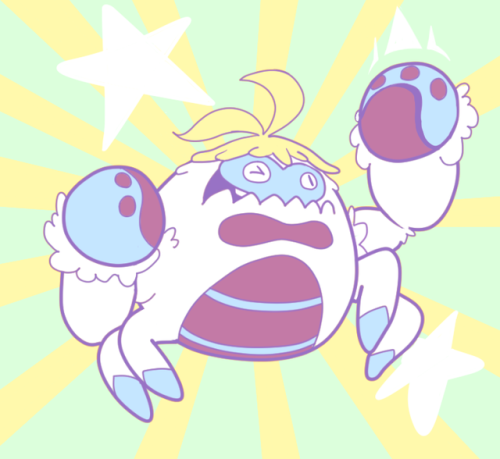#crabominable
most people: crabominable is such a bad pokemon, it’s got a stupid looking design and dumb type
me:

WELCOME TO THE HIMALAYAS
Please take this special crab and good fortune will come to you, but only if you post “thank you Crabominabroble”
just kidding you don’t have to do anything, he’s got your back even if he is a tad slow but for now enjoy this fluffy crab
Post link
Got sick and started a replay of Sun, but here’s a drawing of my first team, always try and stick to new species for my first run each gen. From top to bottom: Shredder, Claymore, Clawshanks, Baskerville, Heartburn, and Skyward.
Post link
Requested Anonymously
Today on “that’s not a pokemon, that’s just a real animal”, let’s talk about Crabominable! Crabominable seems to be based on a real-life creature that lives in the deep ocean Antarctica, the kiwa hirsuta - colloqiually known as the Yeti Crab.

Just like Crabominable, yeti crabs are covered in white fuzz. Unlike Crabominable though, these crabs do not live in the extreme cold. In fact, yeti crabs are found near deep-sea hydrothermal vents - underwater volcanoes where a crack in the sea floor causes the water to be heated up by the magma beneath it. The water near hydrothermal vents can get as hot as 400 degrees celsius (750 degrees Fahrenheit) - even though the water just a short distance away might be in the single digits. Furthermore, hydrothermal vents are deep.Yeti crabs are usually found around 2.2 kilometers (1.5 miles) underneath the ocean’s surface.

How can any animal live in such extreme conditions? The yeti crab’s “fur” is actually it’s secret to survival. Most crabs grow small bristles called setae, which are used to sense motion in the water - kind of like whiskers on a cat. This helps crabs sense danger, find small animals that could be food, or avoid larger animals who think that it is food.
In a yeti crab, however, the setae have an additional function. Most kinds of crabs eat creatures like worms, clams, or sea urchins. Not very many creatures can survive near hydrothermal vents, which means that for the yeti crab, there’s not a lot of things it can eat. Yeti crabs have adapted to eat bacteria instead - and there is a lot of that near the vents! Yeti crab have been observed to use their fur like broomsticks, sweeping up the bacteria on the rocks near the vents. They also sometimes hold their claws right over the vent itself, like it was roasting a marshmallow - this actually helps the bacteria by giving it minerals and warmth, allowing them to divide and reproduce right on the crab’s claw. So all of that fur you see in the first picture in this post? That’s mostly all bacteria. Without any bacteria on it, the yeti crab looks like this:

The yeti crab’s hair-like setae allow it to capture, grow, and farm bacteria near the vents. The yeti crabs are basically growing their own food, using the bristles on their claws as little plant pots to cultivate a “garden” of bacteria. Because of this, the yeti crab ensures that it always has plenty to eat.
Crabominable is based on the Yeti Crab, a deep-sea creature that lives near hydrothermal vents. What looks like fur is actually colonies of bacteria growing on the crab’s claw, which it cultivates like a garden for food.
So if you hug your Crabominable, make sure you wash your hands afterwards.
Post link



![Crabrawler, CrabominableDid You See the Fighting Rainbow[x][x] Crabrawler, CrabominableDid You See the Fighting Rainbow[x][x]](https://64.media.tumblr.com/1b0322b8ea40649b3810d67c688f8ca1/tumblr_os0d082w6M1qza7fho1_400.jpg)
![Crabrawler, CrabominableDid You See the Fighting Rainbow[x][x] Crabrawler, CrabominableDid You See the Fighting Rainbow[x][x]](https://64.media.tumblr.com/c189a35ca60e7ae50582f724fd2f6c99/tumblr_os0d082w6M1qza7fho2_400.jpg)
